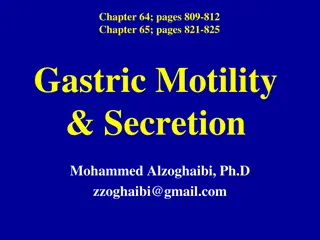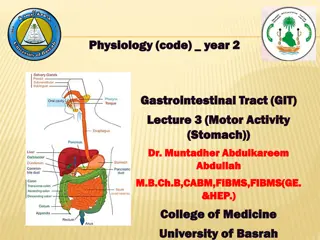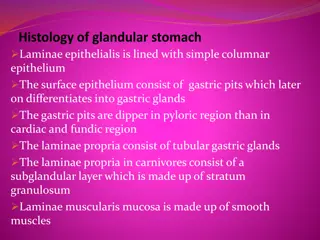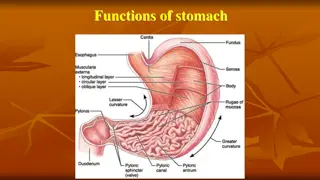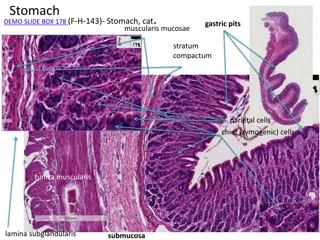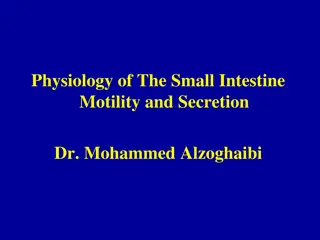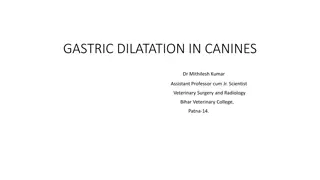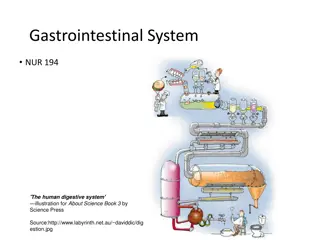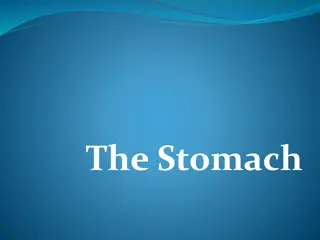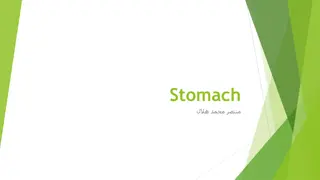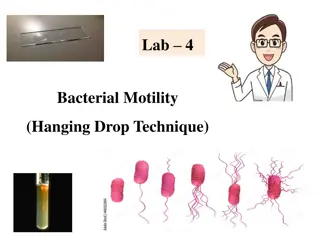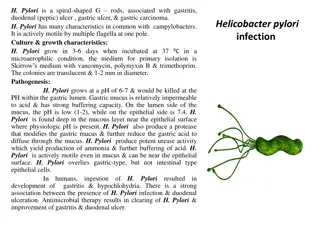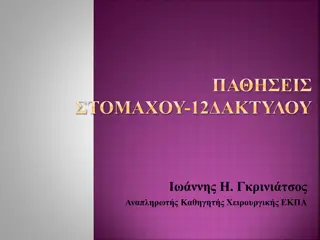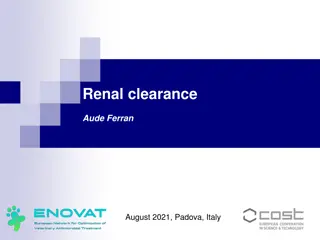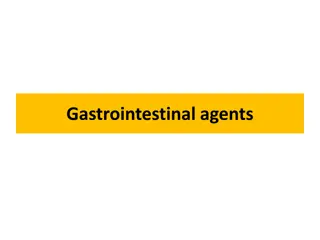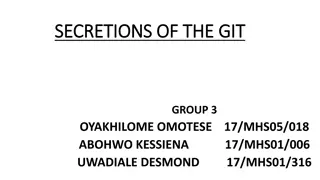Understanding Gastric Motility and Secretion in the Stomach
The stomach plays a crucial role in food processing, acting as a reservoir, preparing chyme for digestion, and facilitating absorption. Divided anatomically and physiologically, it functions as a storage unit and mixing chamber for food. Key motor functions include storage, preparation for digestion, absorption, and regulating chyme emptying. Relaxation reflexes in the gastric reservoir, such as receptive and adaptive relaxation, are triggered by swallowing and stretch receptors, contributing to efficient food processing and movement.
Download Presentation

Please find below an Image/Link to download the presentation.
The content on the website is provided AS IS for your information and personal use only. It may not be sold, licensed, or shared on other websites without obtaining consent from the author. Download presentation by click this link. If you encounter any issues during the download, it is possible that the publisher has removed the file from their server.
E N D
Presentation Transcript
Lecture 3 Chapter 64; pages 809-812 Chapter 65; pages 821-825 Gastric Motility & Secretion Prof. Mohammed Alzoghaibi malzoghaibi@ksu.edu zzoghaibi@gmail.com
Motor Functions of the Stomach The main motor functions of the stomach are: 1. Storage of large quantities of food 2. Preparing the chyme for digestion in the small intestine 3. Absorption of water and lipid-soluble substances (alcohol and drugs) 4. Regulate emptying of the chyme from the stomach into the small intestine
Anatomically and Physiologically Divisions of the Stomach Anatomically the stomach is composed of the fundus, body and the antrum. Physiologically, it is composed of the orad portion (fundus and upper two thirds of the body)- Reservoir part (tonic contraction) and the caudad (lower third of the body plus antrum)-Antral pump (phasic contraction).
Gastric Reservoir The main functions of the upper part of the stomach (Reservoir part ): 1. To maintain a continuous compression 2. To accommodate the received food with out significant gastric wall distention or pressure (Storage of food)
Motor Functions of the Stomach (continued) Storage and Mixing Function of the Stomach. 1. Storage of food. The stomach can store 0.8-1.5 L of food. Gastric contents may remain unmixed for 1hour in the corpus. When the stomach is stretched by food, a vagovagal reflex is initiated from the stomach to the brain stem and back to the muscular wall of the stomach resulting in reduction in muscular wall tone which allows storage. The pressure in the stomach remains low until the volume reaches ~1.5 L of food. This function is regulated by Receptive Relaxation Reflex (vagovagal): Triggered by swallowing reflex.
Relaxation Reflexes in Gastric Reservoir Part Three Kinds of Relaxation Occur in the Gastric Reservoir: A. Receptive Relaxation Reflex: Triggered by swallowing reflex. When the esophageal peristaltic waves reach the stomach, the stomach relaxes through inhibition of myenteric neurons which prepares the stomach to receive the food that is propelled into the esophagus during swallowing.
Relaxation Reflexes in Gastric Reservoir Part (continued) B. Adaptive relaxation: Triggered by stretch receptors (vago- vagal reflex). Normally, when food stretches the stomach, a vagovagal reflex from the stomach to the brain stem and then back to the stomach reduces the tone in the muscular wall of the body of the stomach so that the wall bulges progressively outward, accommodating greater and greater quantities of food up to a limit (0.8 to 1.5 L). This reflex is lost in vagotomy.
Relaxation Reflexes in Gastric Reservoir Part (continued) Adaptive relaxation is lost in patients who have undergone a vagotomy. Following a vagotomy, increased tone in the musculature of the reservoir decreases the wall compliance, which in turn affects the responses of gastric stretch receptors to distention of the reservoir. Pressure volume curves obtained before and after vagotomy reflect the decrease in compliance of the gastric wall. The loss of adaptive relaxation after a vagotomy is associated with a lowered threshold for sensations of fullness and pain. Adaptive Relaxation
Relaxation Reflexes in Gastric Reservoir Part (continued) C. Feedback Relaxation: The presence of nutrients in the small intestine triggers feedback relaxation. It can involve both local reflex connections between receptors in the small intestine and the gastric ENS or hormones that are released from endocrine cells in the small intestinal mucosa and transported by the blood to signal the gastric ENS and stimulate firing in vagal afferent terminals in the stomach
Motor Functions of the Stomach (continued) 2.Chyme. Is a murky semi-fluid or paste composed of food that is thoroughly mixed with gastric secretions.
Motor Functions of the Stomach (continued) 3. Mixing and Propulsion of Food in the Stomach: Major mixing activities take place in the antrum (antral pump region, phasic contraction). The Basic Electrical Rhythm of the Stomach Wall. The digestive gastric juices are secreted by gastric glands and these secretions come in contact with the food lying against the mucosal surface of the stomach. The presence of food causes weak peristaltic constrictor waves called mixing waves once every 15-20 seconds. These waves are initiated by the gut wall basic electrical rhythm of the slow spontaneous electrical waves. These waves progress from the body to the antrum and become intense forcing the chyme to mix and move under high pressure from the antrum toward the pylorus. Each time a peristaltic wave passes from to the antrum to the pylorus, few millimeters of antral content move into the duodenum through the pyloric sphincter.
Motor Behavior of the Antral Pump Is Initiated by a Dominant Pacemaker (Motility in the Antrum) Gastric action potentials determine the duration and strength of the phasic contractions of the antral pump. They are initiated by a dominant pacemaker (ICC). The action potentials propagate rapidly around the gastric circumference and trigger a ring-like contraction. The action potentials and associated ring-like contraction then travel more slowly toward the gastroduodenal junction. Electrical syncytial properties of the gastric musculature account for propagation of the action potentials from the pacemaker site to the gastroduodenal junction. The pacemaker region in humans generates action potentials and associated antral contractions at a frequency of three per minute. The gastric action potential lasts about 5 seconds and has a rising phase (depolarization), a plateau phase, and a falling phase (repolarization)
Motor Behavior of the Antral Pump Is Initiated by a Dominant Pacemaker (Motility in the Antrum) Electrical action potentials in gastrointestinal muscles occur in four phases, determined by specific ionic mechanisms. Phase 0: Resting membrane potential; outward potassium current. Phase 1: Rising phase (upstroke depolarization); activation of voltage-gated calcium channels and voltage-gated potassium channels. Phase 3: Plateau phase; balance of inward calcium current and outward potassium current. Phase 4: Falling phase (repolarization); inactivation of voltage-gated calcium channels and activation of calcium-gated potassium channels.
The Gastric Action Potential Triggers Two Kinds of Contractions The gastric action potential is responsible for two components of the propulsive contractile behavior in the antral pump. (1) A leading contraction, which has relatively constant amplitude, is associated with the rising phase of the action potential, and (2) a trailing contraction, of variable amplitude, is associated with the plateau phase.
The Gastric Action Potential Triggers Two Kinds of Contractions (continued) The leading contractions have negligible amplitude as they propagate to the pylorus. As the rising phase reaches the terminal antrum and spreads into the pylorus, contraction of the pyloric muscle closes the orifice between the stomach and duodenum. The trailing contraction follows the leading contraction by a few seconds.
Retropulsion Phenomena As the trailing contraction approaches the closed pylorus, the gastric contents are forced into an antral compartment of ever- decreasing volume and progressively increasing pressure. This results in jet-like retropulsion through the orifice formed by the trailing contraction. Repetition at 3 cycles/min reduces particle size to the 1-mm to 7-mm range that is necessary before a particle can be emptied into the duodenum. These intense peristaltic contractions that cause emptying increase the pressure in the stomach to 50-70 cm of H2O (compared to a pressure of ~10 cm of H2O during the mixing peristaltic contractions).
Motor Functions of the Stomach (continued) Hunger Contractions. Hunger contractions occur when the stomach has been empty for several hours. These are rhythmical peristaltic contractions that can become very strong and fuse to form a continuing tetanic contraction lasting sometimes 2-3 minutes. Hunger contractions are intense in young healthy people and increase by low blood glucose levels. Hunger pain can begin after 12-24 hr of last food ingestion.
Stomach Emptying Stomach Emptying. Is the result of intense peristaltic antral contractions against resistance to passage of chyme at the pylorus. Role of the Pylorus in Controlling Stomach Emptying. The distal opening is the pylorus. The pyloric sphincter is characterized by strong circular muscle (as compared to the antrum) and remains tonically contracted most of the time. However, during pyloric constriction, watery chyme can still pass through the pylorus into the duodenum, but not food particles. Pyloric constriction is determined by nervous and humoral reflex signals from the stomach and the duodenum.
Stomach Emptying Regulation of Stomach Emptying. The rate of stomach emptying is controlled by signals from the duodenum and stomach. The signals from the duodenum are far stronger and control emptying of chyme at a rate that allows the proper digestion and absorption in the small intestines. Gastric Factors that Promote Stomach Emptying: 1. Effect of Gastric Food Volume on Rate of Stomach Emptying. An increase in gastric food volume results in increased stretch in the stomach wall which elicits local myenteric reflexes that increase the activity of the pyloric pump and inhibit the tonic contraction of the pyloric sphincter leading to increased stomach emptying. 2. Effect of the Hormone Gastrin on Stomach Emptying. Gastrin is released from the antral mucosa in response to the presence of digestive products of meat. In turn, gastrin promotes the secretion of acidic gastric juices (ex. HCl) by the stomach gastric glands (or oxyntic glands) located on the inside surface of the body and fundus of the stomach; (i.e. proximal 80% of the stomach). Gastrin also increases the activity of the pyloric pump and motor stomach function (moderate effect) and probably promotes stomach emptying.
Powerful Duodenal Factors That Inhibit Stomach Emptying: 1. Inhibitory Effect of Enterogastric Nervous Reflexes from the Duodenum. When food enters the duodenum, multiple nervous reflexes are initiated from the duodenal wall and pass back to the stomach to regulate stomach emptying depending on the volume of chyme in the duodenum. These duodenal reflexes are mediated by three routes: (1) directly from the duodenum to stomach through the enteric nervous system in the gut wall, (2) through extrinsic nerves that go to the prevertebral sympathetic ganglia and then back through inhibitory sympathetic nerve fibers to the stomach, and (3), probably to a slight extent through the vagus nerves reflex to the brain stem to inhibit the normal excitatory signals that are transmitted to the stomach through the vagus nerves. These reflexes inhibit the pyloric pump and increase the tone of the pyloric sphincter thus decreasing stomach emptying.
Powerful Duodenal Factors That Inhibit Stomach Emptying (continued) The duodenal factors that can initiate the enterogastric inhibitory reflexes include: (1) duodenal distention, (2) duodenal irritation, (3) duodenal acidity, (4) osmolality of the chyme in the duodenum, and (5) protein (and may be fat) content of the chyme in the duodenum.
Powerful Duodenal Factors That Inhibit Stomach Emptying (continued): 2. Hormonal Feedback from the Duodenum Inhibits Gastric Emptying Role of Fats and the Hormone Cholecystokinin. Fat entering the duodenum or acidity of chyme or excess quantities of chyme causes (probably a receptor mediated mechanism) the release of cholecystokinin (CCK), and probably other inhibitory hormones such as secretin and gastric inhibitory peptide, (GIP) from the epithelium of the duodenum and jejunum. When released, CCK (and probably secretin and GIP) circulates and inhibit the pyloric pump and increase the tone of the pyloric sphincter thus decreasing stomach emptying. CCK also acts as an inhibitor to block increased stomach motility caused by gastrin.
Regulation of Stomach Emptying (Summary) 1. Food Volume: Increased food volume in the stomach promotes emptying from the stomach (inhibits the pylorus). Gastrin hormone: enhances the activity of the pyloric pump. Thus, it, too, probably promotes stomach emptying. 2. Powerful Duodenal Factors That Inhibit Stomach Emptying At the presence of food in the duodenum, multiple nervous reflexes are initiated from the duodenal wall that pass back to the stomach to slow or even stop stomach emptying via one of the following routes:(1) directly through ENS, (2) through extrinsic nerves that go to the prevertebral sympathetic ganglia and then back through inhibitory sympathetic nerve fibers to the stomach, and (3) through the vagus nerves. Gastric Factors That Promote Emptying
Regulation of Stomach Emptying Summary (continued) The types of factors that can initiate enterogastric inhibitory reflexes include the following: 1. The distention of the duodenum. 2. Acidity of the duodenum activates S cells to release Secretin which constricts the antrum. 3. Fat (monoglycerides) in the duodenum activates different cells to produce CCK and GIP that delay gastric emptying. 4. Hyperosmotic or hyposmotic solutions delay gastric emptying. 5. Amino acids elicit inhibitory enterogastric reflexes; by slowing the rate of stomach emptying.
Summary Constriction of Pyloric Sphincter Hormones promote constriction of pyloric sphincter and inhibit stomach emptying: 1. Cholecystokinin (CCK) 2. Secretin 3. Glucose-dependent insulinotropic peptide (GIP) Sympathetic innervation
Chapter 65; pages 821-825 Gastric Secretion The stomach's mucosal lining, the glandular gastric mucosa, contains three main types of glands: 1. Cardiac Glands 2. Oxyntic glands. They are composed of three types of cells: mucus neck cells, peptic (Chief) cells, and parietal cells (Oxyntic cells). These glands are the most abundant gastric glands, found in fundus and corpus 3. Pyloric glands (many G cells)
Structure of a Gastric Oxyntic Gland HCl is secreted across the parietal cell microvillar membrane and flows out of the intracellular canaliculi into the oxyntic gland lumen. The surface mucous cells line the entire surface of the gastric mucosa and the openings of the cardiac, pyloric, and oxyntic glands. These cells secrete mucus and HCO3- to protect the gastric surface from the acidic environment of the stomach. The distinguishing characteristic of a surface mucous cell is the presence of numerous mucus granules at its apex.
Types of Cells Parietal cells (oxyntic cells): most distinctive cells in stomach (HCl & intrinsic factor). Chief cells (peptic cells), they are available in oxyntic glands and few in pyloric glands (pepsinogen). Mucus neck cells: HCO3- and mucus. G Cells: Gastrin (hormone) increases HCl secretion from Parietal cells. D Cells: Somatostatin (in the antrum part of the stomach) decreases HCl secretion. Enterochromaffin-like cell: Histamine.
Gastric juice: HCL Pepsinogen Electrolytes Intrinsic factor Mucus (mucus gel layer)
Mechanism for secretion of hydrochloric acid (HCl) 1. Chloride ion is actively transported from the cytoplasm of the parietal cell into the lumen of the canaliculus, and sodium ions are actively transported out of the canaliculus into the cytoplasm of the parietal cell.
Mechanism for secretion of hydrochloric acid (continued) 2. Water becomes dissociated into hydrogen ions and hydroxyl ions in the cell cytoplasm. Thehydrogen ions are then actively secreted into the canaliculus in exchange for potassium ions. 3. Carbon dioxide, either formed during metabolism in the cell or entering the cell from the blood, combines under the influence of carbonic anhydrase with the hydroxyl ions to form bicarbonate ions. These then diffuse out of the cell cytoplasm into the extracellular fluid in exchange for chloride ions that enter the cell.
HCL Secretion (summary) Mechanism of HCl production: Depends on H/K ATPase Inhibited by: omeprazole H/K pump depends on [K]out [HCl] drives water into gastric content to maintain osmolality During gastric acid secretion: amount of HCO3- in blood = amount of HCl being secreted Alkaline tide
Gastric Secretion Is Under Neural and Hormonal Control Gastric acid secretion is mediated through neural and hormonal pathways. Vagus nerve stimulation is the neural effector; histamine and gastrin are the hormonal effectors. Parietal cells possess special histamine receptors, H2 receptors, whose stimulation results in increased acid secretion. Special neuroendocrine cells of the stomach, known as enterochromaffinlike (ECL) cells, are believed to be the source of this histamine. They are located mostly in the acid-secreting regions of the stomach. The mechanisms that stimulate the ECL cells to release histamine are poorly understood. The effectiveness of cimetidine, a H2 blocker, in reducing acid secretion has indirectly demonstrated the importance of histamine as an effector of gastric acid secretion. H2 blockers are commonly used for the treatment of peptic ulcer disease or gastroesophageal reflux disease.
Agents that stimulate and inhibit H+ secretion by gastric parietal cells
Neural & Hormonal Control of Gastric Secretion Vagus nerve (neural effector) either by releasing Ach (direct activation of parietal cells) or by releasing Gastrin releasing peptide, GRP (indirect activation). Gastrin (hormonal effector) Enterochromaffin-like cells release Histamine activates H2 receptor (parietal cells) increases acid secretion Cimetidine (H2 receptor blocker) peptic ulcer and gastroesophageal reflux
The Rate of Secretion Modify the Composition of Gastric Juice At a low secretion rate, gastric juice contains high concentrations of Na+ and Cl- and low concentrations of K+ and H+. When the rate of secretion increases, the concentration of Na+ decreases whereas that of H+ increases significantly. Also coupled with this increase in gastric secretion is an increase in Cl- concentration. To understand the changes in electrolyte composition of gastric juice at different secretion rates, remember that gastric juice is derived from the secretions of two major sources: parietal cells and nonparietal cells. Secretion from nonparietal cells is probably constant; therefore, it is parietal secretion (HCl secretion) that contributes mainly to the changes in electrolyte composition with higher secretion rates.
The Rate of Secretion Modify the Composition of Gastric Juice (continued) Low secretion rate (between meals) - high NaCl. High secretion rate (after a meal)- high HCl. Always isotonic.
Gastric digestive enzymes Several types of pepsinogen secreted from chief cells. They are activated by HCl into pepsin and once activated, they can activate more pepsinogen. The optimum pH is 1.5-3.5. Pepsin breaks down proteins into peptones & polypeptides. Pepsinogen secretion is stimulated by Ach, acid, gastrin, secretin & CCK.
Intrinsic Factor It is glycoprotein secreted by parietal cells. It is the only essential function of stomach as it is essential for vitamin B12 absorption. Atrophy of gastric mucosa leads to pernicious anemia.
Gastric Secretion Occurs in Three Phases: The stimulation of acid secretion resulting from the ingestion of food can be divided into three phases: the cephalic phase, the gastric phase, and the intestinal phase: 1. The cephalic phase involves the central nervous system. Smelling, chewing, and swallowing food send impulses via the vagus nerves to the parietal and G cells in the stomach. The nerve endings release ACh, which directly stimulates acid secretion from parietal cells. The nerves also release gastrin-releasing peptide (GRP), which stimulates G cells to release gastrin, indirectly stimulating parietal cell acid secretion.
Gastric Secretion Occurs in Three Phases (continued): 2. The gastric phase is mainly a result of gastric distention and chemical agents such as digested proteins. Distention of the stomach stimulates mechanoreceptors, which stimulate the parietal cells directly through short local (enteric) reflexes and by long vago-vagal reflexes. Digested proteins in the stomach are also potent stimulators of gastric acid secretion, an effect mediated through gastrin release. Several other chemicals, such as alcohol and caffeine, stimulate gastric acid secretion through mechanisms that are not well understood. 3. During the intestinal phase, protein digestion products in the duodenum stimulate gastric acid secretion through the action of the circulating amino acids on the parietal cells. Distention of the small intestine, probably via the release of the hormone entero- oxyntin from intestinal endocrine cells, stimulates acid secretion.
Gastric Secretion Occurs in Three Phases 1. Cephalic phase(30%): Smelling, Chewing and swallowing Stimulate parietal G- Cells (via GRP) 2. Gastric phase (60%): gastric distention proteins 3. Intestinal phase (10%): digested proteins
Gastric Secretion Occurs in Three Phases (cont d)
Inhibition of Acid Secretion Inhibitory hormones (Enterogastrones): Somatostatin (D-cells) in antrum Secretin (S-cells) in duodenum Glucose-dependent insulinotropic peptide (GIP) in duodenum
View drug View drug View drug View drug View drug information information information information information Site of Secretion Stimuli for Secretion Protein Distention of the stomach Vagal stimulation (GRP) (Acid inhibits release) Protein Fatty acids Acids Hormone Actions G cells of the antrum, duodenum and jejunum Stimulates: Gastric H+ secretion and growth of gastric mucosa Gastrin Stimulates: Pancreatic enzyme secretion, Pancreatic HCO3- secretion, gallbladder contraction, growth of the exocrine pancreas, and relaxation of the sphincter of Oddi. Inhibits: gastric emptying Stimulates: Pepsin secretion, Pancreatic HCO3- secretion, Biliary HCO3- secretion, and growth of the exocrine pancreas. Inhibits: Gastric H+ secretion Stimulates: Insulin secretion from pancreatic cells Inhibits: Gastric H+ secretion Cholecystokinin (CCK) I cells of the duodenum, jejunum, and ileum Acids and Fat in the duodenum Secretin S cells of the duodenum, jejunum, and ileum Protein Fatty acids Oral glucose Glucose-Dependent Insulinotropic Peptide (GIP) Motilin K cells of the Duodenum and jejunum M cells of the duodenum and jejunum Fat Acid Nerve Stimulates: Gastric motility Intestinal motility



